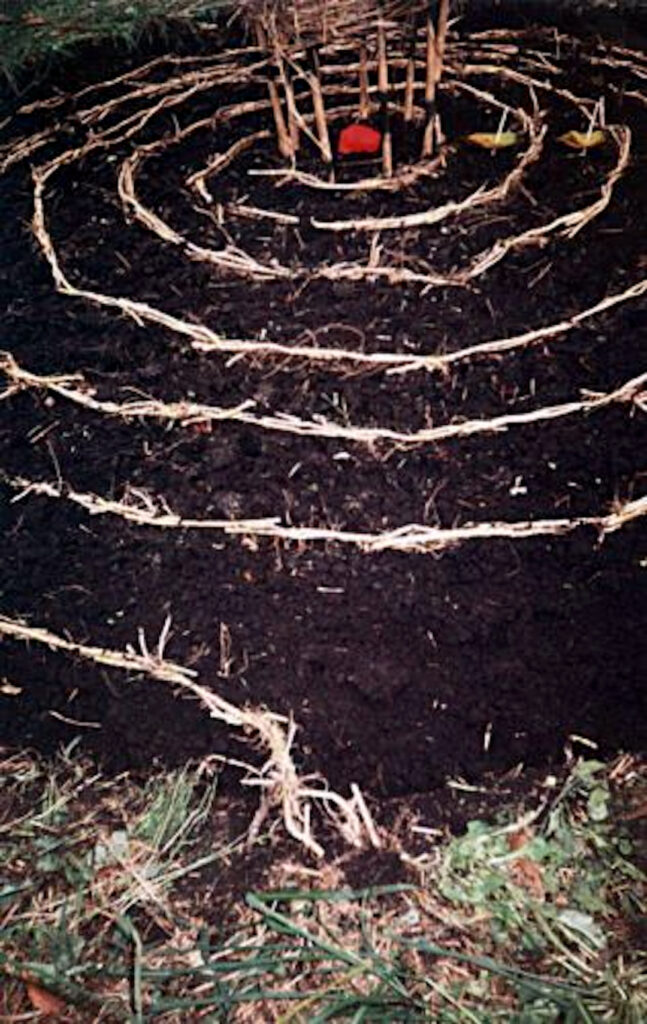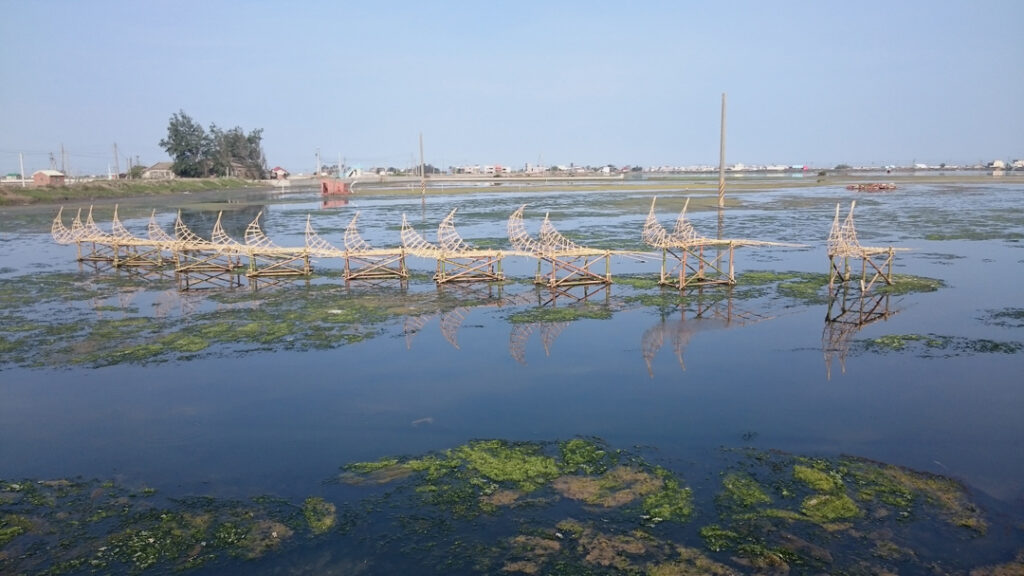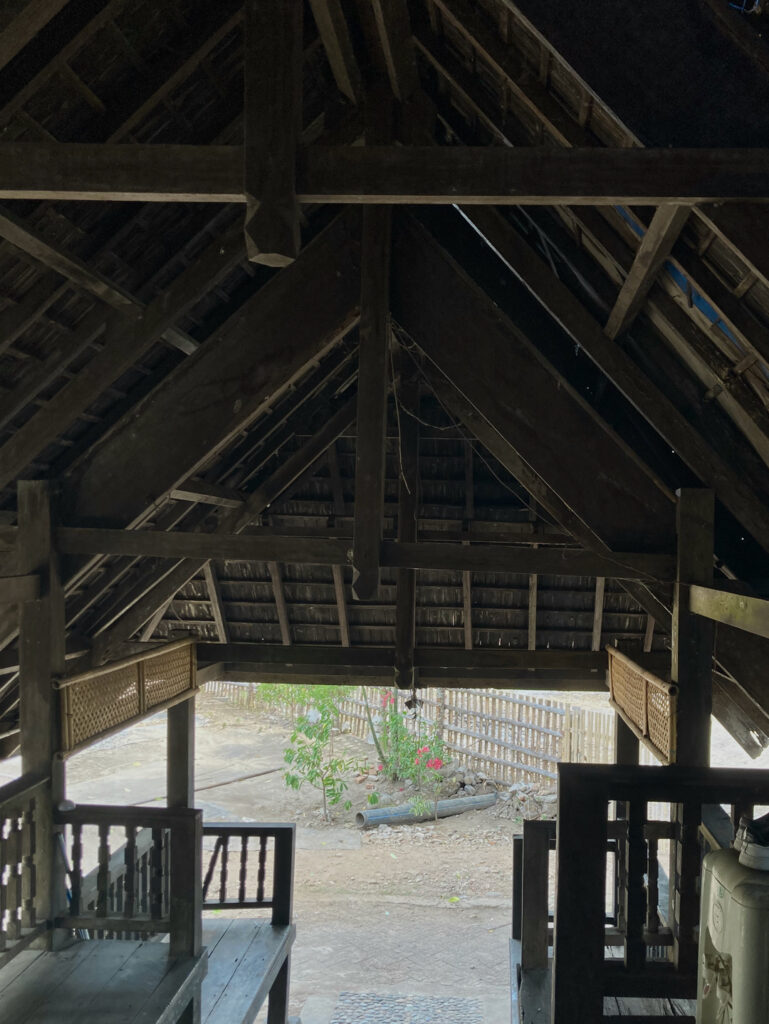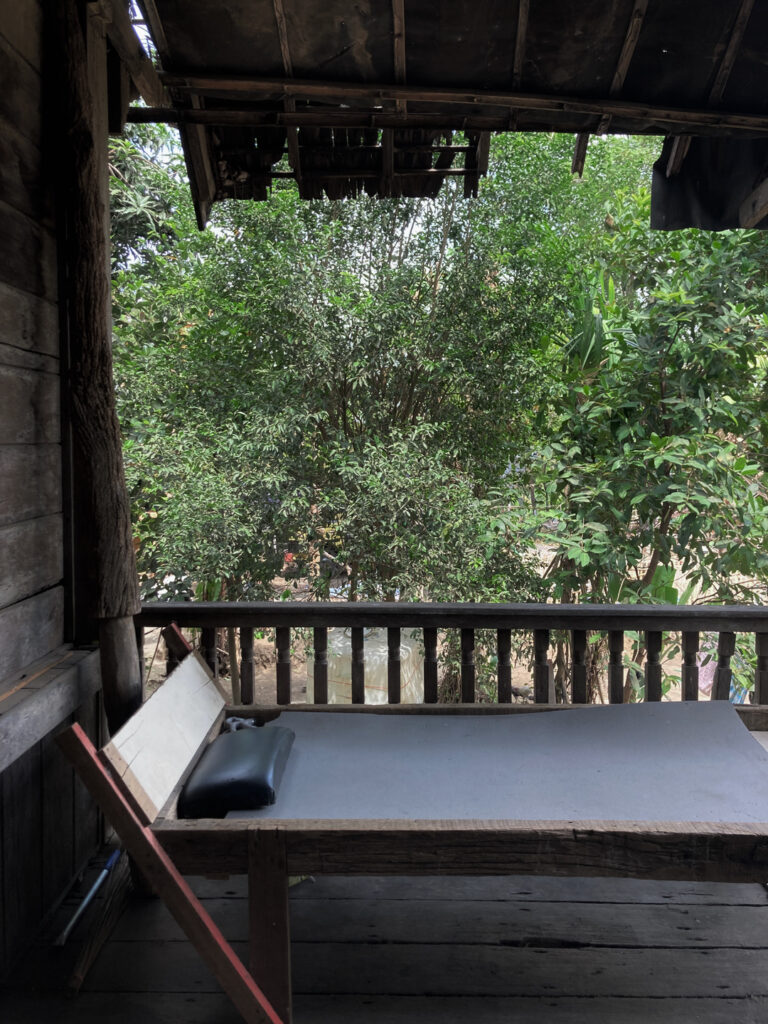Caitlin Hughes reflects on regenerative bamboo sculptures by a Makassar-based artist that bridge far-flung worlds.
It was early on a Saturday morning, November 2023, when I met with artist Firman Djamil at his former studio, Somba Opu Studio and Gallery, on the grounds of benteng (Fort) Somba Opu in the outer suburbs of the city of Makassar, South Sulawesi. There are many layers to this place. In the sixteenth century, it was the centre of commerce and royalty for the Gowa Sultanate. It was the strongest of the Gowa forts until Somba Opu became the epicentre of the Makassar War in 1669; when the Dutch East India Company (VOC) seized control of, and subsequently destroyed, the fortress.
For the next 330-odd years, Somba Opu was abandoned. The bricks of the fort wall were dismantled and repurposed to build Dutch colonial houses; the original site was rediscovered in the 1980s. In the 1990s, a “Miniature Sulawesi” park was built here by the South Sulawesi provincial government. It is an outdoor showcase of South Sulawesi’s many ethnic, traditional houses around a dirt and asphalt track, including stately and stilted Bugis houses, Makassar houses, Luwu and Selayar homes, and Tana Toraja’s famed boat-shaped tongkonan.
These variations in architectural style at Miniature Sulawesi reveal the many-layered cultural and tribal influences in the South Sulawesi region. It is a multiplicity that shapes everyday life: a diversity and a homeliness. In the colonial era, Makassar had a famed, and now somewhat faded, status as an international port city. Today, visions for tempo doeloe (the olden days) are a subject of nostalgia and pride in the community. Over time, Miniature Sulawesi has also fallen into varying states of disrepair. Unfortunately, this includes Pak Firman’s studio at the fringes of the park, where he made art for 23 years until 2013, and contributed regularly to the art ecosystem of Somba Opu.
- Outside Somba Opu Studio and Gallery, Makassar, November 2023; photographs by Caitlin Hughes
As Firman and I sat outside on the studio’s front verandah that morning, campfire-cooking smoke wafted from a nearby house, interspersed with the sounds of chainsaws and calls to prayer. The smells and sights around Somba Opu reminded me of the bushland in coastal North-East Tasmania, where my grandmother once lived in her weatherboard shack: a transporting-shuttling-teleporting from one island to another and back again.
✿
I am not the only one who has experienced this shifting and displacing quality on a visit to studio Somba Opu. Poet Afrizal Malna had, in 2006, observed that entering the house was “like entering the epic Bugis-Makassar stories”; reflecting that:
There is a small schizophrenic shock when feet begin to ascend the steps [to Firman’s studio] … I know I am not entering the discourse of contemporary Indonesian art. But something different, something suggestive, something for which there is not yet a place [in contemporary art discussion] … for those cast aside by Indonesian modernisation.
Makassar is a long way from the urbanised or gentrified hotspots for Indonesian contemporary art, largely found on the island of Java; in the cities of Jakarta, Bandung and Yogyakarta. Born in the regency of Bone, South Sulawesi, in 1964, and today living in Makassar, Firman has carved out his own artistic pathway that sometimes rebels against, and often transcends, the conventional aesthetics and art-market-friendly attributes expected for contemporary Indonesian art. But Firman’s art is indeed contemporary. It is a pulse detected in his paintings and performances, and especially in his primary artistic medium: environmental art. He draws deep from his Bugis heritage as inspiration for such works. Yet this is not to create a push-pull tension between “tradition” on the one hand and “contemporaneity” on the other. Rather, these influences and experiences come together as a cohesive, whole togetherness.
Having produced most of his large environmental commissions outside of Indonesia, Firman’s immersive, sculptural artworks become metaphorical bridges or portals of translation. It is seni lingkungan, “environmental art”, in Bahasa Indonesia, but more than that. It is Firman’s own re-genre-ing of the concept; not fixed or tied to European or American meanings, but freed to explore a multilayered alternative. In that middle-space emerges new encounters with art, environments, and the world.
✿
Firman began his career by training as an art teacher at IKIP Ujung Pandang. Ujung Pandang or “Pandanus Point” was Makassar city’s previous name for a time between 1967 and 1999. For ten years, from 1990 to 2000, he travelled back and forth between Somba Opu and Pondingao, an isolated village on the border of Tana Toraja and Mamasa regencies, and the border between West and South Sulawesi, where he taught art at a local school. Active since the 1980s, Firman is regarded as a prominent figure in the contemporary art and performance community in Makassar, making public installations, public performances, and happening artworks. A series of intra-national exhibitions and experimental art convergences in Indonesia in 1999 and the early 2000s would prompt a shift in his art practice towards environmental art. What followed was a turn to the international.
In 2000, Firman was invited to attend the 2nd Yokohama International Open Air Art Exhibition in Yokohama, Japan. There he presented Root Ritual (2000); an artwork made of bamboo, grass, and the roots of grass, rice and other plants. Combing and twining these roots together in a snaking, spiral formation, Firman then staked cuttings of yellow bamboo into the centre. Above that he rested a bird’s nest.

Firman Djamil, “Root Ritual” (2000), Outdoor installation and performance artwork; with bamboo, grass, roots of grass, rice, and other plants; dimensions variable. Made for the 2nd Yokohama International Open Air Art Exhibition, Yokohama, Japan, 2000. Image courtesy of the Indonesia Visual Art Archive (IVAA).
Bamboo is an important part of Bugis mythology, especially yellow bamboo. In Bugis storytelling, To-Manurung refers to the mythology of the first person on earth who descended from the sky, which is given form through many aspects of Bugis cosmology. By coincidence, in Japan, there is also the mythology of The Story of the Bamboo Cutter, a ninth-century Japanese fairytale detailing the life of Kaguya-hime; a princess from the Moon who was found as a baby inside a glowing stalk of bamboo.
“In my work … there is a meeting of paradoxes. From those paradoxes, I want to create something that ensures survival.”
Root Ritual references these living bamboo spirits in the use of yellow bamboo, sourced from a nearby bamboo plantation that was being prepared for urban development. In this context, the artwork had another interpretation; drawn from the Bugis epic poem and cycle, La Galigo, the Bugis creation story inscribed in Bugis-Makassar Lontara’ scripture, central to the Bugis world(s) and its cosmologies. This second meaning is what Firman described as a “paradox”: bamboo is cut down to make perahu (boats), destroying the natural habitat for birds. “It’s about scientific knowledge … but [also] the consequences of that science,” Firman commented: “In my work … there is a meeting of paradoxes. From those paradoxes, I want to create something that ensures survival”. The large whitish spiral track spun on the dark soil around the bird’s nest; with, as Firman described, “the hope that these roots become a spirit for sustainable survival”.
At the Yokohama exhibition’s Symposium, Firman met Indonesian-Australian artist, Dadang Christanto. Firman was an invited panellist for the exhibition’s symposium, and Dadang acted as his translator. Environmental art, as its own sculptural, spatial, and formal medium for art practice, is sometimes a sidelined genre in mainstream histories of Indonesian contemporary art, and in certain aspects of university art education. However, in the early 2000s, a core group of artists were branching out into this territory, including Firman and Dadang. The booming platforms of 2000s-era East Asian nature art exhibitions enabled new opportunities and new forms of art making. This type of “Indonesian” environmental art (if indeed it could be described by such national terms) was tethered to a largely international setting. In this context, seni lingkungan is therefore neither import nor export. Rather, it is best understood as a specific artistic translation of personal encounters and experiences in a trans-place, transnational movement.
Emblematic of this idea, Firman’s artistic journey since Yokohama in 2000 has followed a largely international trajectory: including multiple visits to South Korea and Japan; the staging of a participatory performance artwork in Australia (in Byron Bay, 2005); and repeated exhibitions in Turkiye and Taiwan. In the 2010s, his flight path continued further afield: to the Netherlands, Romania, Canada and Hungary. Each new location shapes and expands the critical horizons for his environmental art practice. In turn, the resulting artworks create a dialogue with space, and with spirit.
✿
From early explorations, what has emerged through Firman’s art practice is a sustained interest in the medium of bamboo. The sculptures made with bamboo have a certain strength in their size and scale: a sturdiness but also an intricacy. It is a play with form and a play with message, exploring materiality and meaning. The story of To-Manurung is woven into many of these artworks. But at their essence, Firman’s artworks are about the experience of sharing and making environments-in-common, of finding things in common in disparate, far-flung places. Bamboo is an important place-based and cultural object in many locations around the world, especially across the Asia-Pacific region. It is a translocational medium and a thing-in-common through which to weave new experiences together.

Firman Djamil, “Bamboo Tunnel” (2006), Outdoor sculptural installation, made from bamboo; 700 x 130 (diameter) cm. Made for the Geumgang Nature Biennale, Geumgang, South Korea, 2006. Image courtesy of the Indonesia Visual Art Archive (IVAA).
At the Geumgang Nature Biennale in South Korea, 2006, Firman presented Bamboo Tunnel (2006). At seven metres long, and with a front circular opening of approximately 1.3 metres in diameter, the ‘tunnel’ was fashioned as a giant bubu; a fish trap form found in various Indonesian (including Maluku and Papua), Malay, Singaporean, Filipino and Bruneian cultures, used for catching fish in the river.
Compared to traditional bubu, which are much smaller in their build, Bamboo Tunnel is deliberately oversized. Not only this, but the artwork has been placed in an inland area. In this position, in the forests of South Korea, the context and experience shift. Here, far from the waters of Southeast Asian island fishing, the structure becomes a spiralling vortex sculpture. It is a passageway, too narrow for human visitors, but a filter for sunlight, greenery, and clean forest air. It is a breathing space, a seeing space, through which to reflect and refract a view of the surrounding landscape.
Firman commented that the artwork represented the imbalances of everyday, contemporary life and the environment. On the one hand, there are the fast-paced realities of modern material, and consumerist lifestyles. And on the other, there is the degrading of the natural world and the loss of ancient knowledge. But this opens out to a secondary view: as a reminder of the need to find balance and, in turn, a visualisation of balance itself. The spokes and supporting bamboo structure plunge in deep towards a distant end and, from the other direction, the ribbed, circular weavings ripple outwards, forwards, in an undulating motion. There is a formal symmetry here; a slowness. A response to the surroundings that breathes in, followed by a long, deep exhale.

Firman Djamil, “Zero Chimney” (2008), Outdoor sculptural installation, made from bamboo, corn seeds, grass; 800 cm x 350 (base) cm. Made for the Guandu International Nature Art Festival, Taipei, Taiwan, 2008. Image courtesy of Timothy S. Allen.
Two years later, Firman participated at Guandu International Nature Art Festival in Taiwan, making Zero Chimney (2008). Zero Chimney is a cylindrical, vertical smokestack around eight metres high. It is a sculpture that starts thicker and becomes thinner, creating the shape of a long bottle or bell that rises tall above the surrounding, grassy landscape. The central frame of the sculpture was made with long, vertical stakes of bamboo arranged in a circular formation. Bamboo is wrapped and woven to create a series of repeated circular bands around the sculpture; floating higher and taller. The circular base of the chimney was lined with grass, on which corn seeds were planted.
Zero Chimney was intended as a critique of alternative energy production, specifically of ethanol. Ethanol as agrifuel is made from fermented maize and corn. Firman had observed that the ethanol manufacturing process for energy resulted in a loss of agricultural land and significant environmental damage. Fermentation processes, too, use up vast amounts of clean water. In place of this destruction, Firman chose to make a sculpture that generated a cleaner and more useful alternative: corn as food, as plant and sustenance, which is, in turn, regenerative.

Firman Djamil, “Fuel Flue” (2009), Outdoor sculptural installation, made from wood branches, leaves, corn seeds; 700 cm x 400 (base) cm. Made for the Drenthe International Art in Nature Symposium & Exhibition, Drenthe, Netherlands, 2009. Image courtesy of the artist.
In both Zero Chimney and Bamboo Tunnel, we can observe various environmental, translational and mythological paradoxes brought to life through bamboo sculpture. In their different ways, they are objects and sculptures that serve a function; primarily intended as sculptures that restore and better the landscape. Tunnels and spirals provide a different view of place and spirit, and corn plants clean the air. These sculptures move and grow with purpose, infused with social and environmental meaning. After the craft and work of sculpting the artwork, there comes a time when nature will take over; controlling the end form. The premise for Zero Chimney would be repeated in later works, including in the Netherlands (Fuel Flue, 2009), and Canada (O2 Chimney, 2011).
✿
In Taiwan in 2011, Firman continued making his growing, moving, living bamboo sculptures at the Cheng Long Wetlands, where he presented Cheng Long Spiral (2011). A bamboo structure starts at the side of the wetland’s banks and plunges down to the water’s surface. In this descending movement, the path of the bamboo swings and swirls around to the right. Grass and shrubs native to the wetlands are planted in the middle of the installation along with tomatoes, sea purslane, and canavalia rosea; nourished by volcanic ash from Indonesia. Over time, these plants climbed, pushed and grew further across the length of the spiral; becoming a resting place for birds, fish, and other local animals.

Firman Djamil, “Cheng Long Spiral” (2011), Outdoor sculptural installation, made from bamboo, reeds, earth, sand, soil, natural twine and rope, oyster shells, living plants, seeds (tomato, sea purslane, and canavalia rosea), seaweed, fish nests, volcanic ash from Indonesia; 100 cm x 2400 cm. Made for the Cheng-Long Wetlands International Environmental Art Project, Taiwan, 2011. Image courtesy of Timothy S. Allen
Cheng Long Spiral shares obvious visual similarities with a more famous artwork: Robert Smithson’s Spiral Jetty (1970), located in Corinne, Utah, in the United States. The comparison with Spiral Jetty is clear, but at times, it is an overpowering and overstated one. Although Firman notes the surface-level similarities between his work and Smithson’s in his artist’s statement, Cheng Long Spiral diverges through a different context and meaning. It charts a course with reference to Bugis mythology and the To-Manurung again. Here, the To-Manurung man is invoked in the use of split bamboo, while the To-Manurung woman emerges from ocean foam, in this case, represented by the spiral movement and pathway. This form follows the counter-clockwise rotation of Bugis cosmology; where the To-Manurung man and woman meet and rule the world for human beings.
The spiral therefore has a spiritual significance in this artwork. Yet it also has an aesthetic form and a practical one. Like Firman’s series of smokestack sculptures, the Cheng Long Spiral is also a regenerative sculpture that intends to feed the surrounding environment. Hanging off the bamboo structure are a series of fish nests, to bring sustenance to the wetlands ecosystem. Above it, seeds and grass are planted in the centre, spiralling and growing outwards. This is an artwork, then, that has sought to respond to the varied needs of Cheng Long’s wetland environments. The land surrounding Cheng Long is subsiding, slowly being submerged by seawater and the effects of a changing climate. In this situation, bamboo is a strong material to withstand salt water. Firman uses this floating, strong bamboo structure as a place of rest and respite for the local wildlife, birds and marine life; decorated with grass, flowers, and tomato plants.
In this context, Cheng Long Spiral is not a direct appropriation of Spiral Jetty, as it may appear at first. It functions instead as a physical pathway both of spirit and for the local ecosystem. It integrates the spiritual as part of this embodied ecological sculpture, and in doing so, extends the reach of a Bugis environmental cosmos.

Firman Djamil, “9 Waves” (2018), Outdoor sculptural installation, with bamboo and natural rope; 300 cm x 2700 cm. Made for the Cheng-Long Wetlands International Environmental Art Project, Taiwan, 2018. Image courtesy of the artist.
In 2018, Firman again participated in the Cheng Long Wetlands International Environmental Art Project. For this exhibition, curated by Jane Ingram Allen, the theme was the number nine, to mark nine years of the Cheng Long Wetlands art project. Firman presented 9 Waves; a series of nine bamboo, wave structures that rise up tall like the sails of Bugis pinisi and padewakkang ship vessels. The bamboo crests pierce the air and keep rolling on, rippling.
On 9 Waves, Firman commented that “waves for Bugis people symbolise strength, perseverance, and challenges in navigating the ocean, as well as navigating life in various lands to share materials, traditions, experiences and spirits”. The Bugis have always been famed sailors and seafarers, travelling as far afield as Madagascar or Thailand, and, indeed, to Yolngu Country in Australia’s Top End. The histories of trepang trade between Makassar and the nearby Indonesian islands, China, and the Yolngu people are well known in Australian history. But in contemporary (and especially Australian) contexts, its history is still principally interpreted as a two-place exchange between Indonesia and pre-colonial (then colonial) Australia. By contrast, the seafaring foundations to Bugis’ identity and experience necessitate a further, longer, multiplied view of place; beyond singular sites, and certainly beyond frameworks of the national. Firman’s artwork here and across his oeuvre returns to an understanding and experience of place that is, instead, founded in multiplicity: just like the cultural makeup and historical layers to South Sulawesi life itself.” It is a view where each place is a node or star in a larger constellation.
✿
Bamboo carries culture and spiritual meaning in South Sulawesi, as in Indonesia, as in the broader Asia-Pacific region where most of Firman’s environmental artworks have circulated. It is a translational device and an experience in common. Through the flexibility and architectural nature of his bamboo sculptures, place becomes a passage through which to encounter environmental art and environmental issues in a different light, a philosophy intended as a regenerative experience. These are sculptures designed to leave no impact on the natural environment. Instead, they aim to better it. Here, then, the mediums and sculptures made by Firman may be considered a bridge or wave between one place and another; between one culture and another. Moving and travelling with the multilayered perspective of South Sulawesi plurality, Firman’s artworks and environmental concerns are not anchored to one place, but instead ripple and flow to an expansive everywhere.
About Caitlin Hughes
 Caitlin Hughes is a Melbourne-based researcher, writer, and PhD Candidate in Art History and Curatorship at the University of Melbourne, where her dissertation examines “post-global” internationalisms in Indonesian art after 1998. This research encompasses Eastern Indonesian art as part of an interdisciplinary focus, especially from Makassar. She is interested more widely in contemporary art from the Asia-Pacific region; including ideas of interactivity, play, public art, urban/environmental aesthetics, and art historiography. Caitlin holds a Bachelor of Arts (Art Theory, Asian Art History) and a Bachelor of Art History and Curatorship (Honours, First Class) from the Australian National University, Canberra, where she graduated in 2020.
Caitlin Hughes is a Melbourne-based researcher, writer, and PhD Candidate in Art History and Curatorship at the University of Melbourne, where her dissertation examines “post-global” internationalisms in Indonesian art after 1998. This research encompasses Eastern Indonesian art as part of an interdisciplinary focus, especially from Makassar. She is interested more widely in contemporary art from the Asia-Pacific region; including ideas of interactivity, play, public art, urban/environmental aesthetics, and art historiography. Caitlin holds a Bachelor of Arts (Art Theory, Asian Art History) and a Bachelor of Art History and Curatorship (Honours, First Class) from the Australian National University, Canberra, where she graduated in 2020.



